Intro: In Laos there are no exclusively gay venues, no gay organizations, no activists, no out periodicals, no push for equality, no gay restaurants or hotels. Ironically, Laos is possibly one of the ‘safest’ places to be gay outside of pro-gay western countries. Although there are no specific laws that criminalize homosexuality, the topic is virtually completely avoided in public, authorities do not spy on gays or arrest anyone unless they become too overt or political, and no one steps out of line to advocate rights or equality. The safety is in the silence.
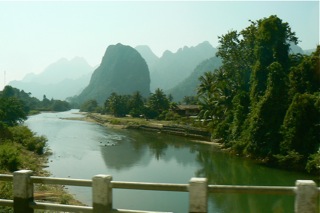
Also see:
Story: Gay Luang Prabang 2010
Story: Gay Laos 2000
Gay Laos News and Reports
Laos Photo Galleries
By Richard Ammon
GlobalGayz.com
Lay of the Land
(photo right, Mekong River and karst mountains near Vang Vieng)
Stepping into Laos is to go back in time where life is more basic, more rural, cautiously progressive, conservative and quietly ruled by repressive strong authorities not hesitant to tell people how to run their livers. The country is small (about about 5 million people and the size of the U.S. state of Minnesota) landlocked between Thailand and Vietnam, and governed by a Communist Party although there is much individual freedom and free enterprise–with restrictions: a foreigner can own a business but not property.
The land is mostly unspoiled and beautifully mountainous with close cultural and linguistic ties with Thailand yet is decidedly independent. During the US-Vietnam conflict the country suffered from secret American bombings and still has economic problems due to millions of 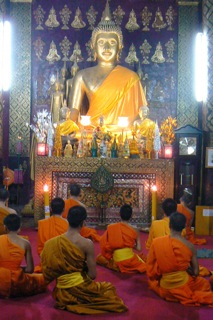 unexploded ordnance (UXO), mines and bombs that prevents much land area from residential and farming use.
unexploded ordnance (UXO), mines and bombs that prevents much land area from residential and farming use.
There has been increased foreign investment of money and technology over the past 30 years from individual business people, from other governments and many NGOs–and most hotels have WiFi. Laotians are quite friendly (passive) and welcoming but are more reserved than Thais. The country is filled with Buddhist temples (photo left), both humble and grand, and retains much old European architecture along with new stylish architecture. Read this report about Lao history.
Unseen LGBT Life
In Laos there are no exclusively LGBT venues, organizations, activists, periodicals, no push for equality, no restaurants or hotels. Ironically, Laos is possibly one of the ‘safest’ places to beour community outside of certain western countries. The topic is virtually completely avoided in public, authorities do not spy on LGBTs or arrest anyone unless they become too overt or political, and no one steps out of line to advocate rights or equality.
This ‘safety zone’ is the result of government repression (veiled but real). Individual inhibitions and self-censorship, along with cultural indifference and ignorance, which mute any outward expression of sexuality. The LGBT community is not identifiable here. An observer can’t go to any one place and point out ‘the queers’, other than obvious individual fem-guys and certain obvious kathoeys–transvestites and transexuals. (Most young kathoeys are not easy for an outsider to spot since young male Asian faces have a smooth aspect that’s further enhanced by make-up.)
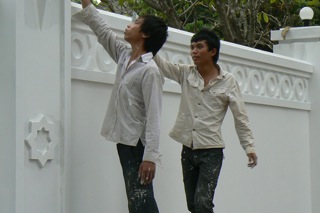 Rather, LGBT people are woven into the general population fabric in a manner that makes them nearly invisible. The majority of LAO men are not gay yet they can be mistaken for such given their smooth, androgynous faces, slight body sizes and ‘feline’ shapes. Lao men don’t exude the typical macho mode so common in the West.
Rather, LGBT people are woven into the general population fabric in a manner that makes them nearly invisible. The majority of LAO men are not gay yet they can be mistaken for such given their smooth, androgynous faces, slight body sizes and ‘feline’ shapes. Lao men don’t exude the typical macho mode so common in the West.
This is a palpable difference to homosexuality in this culture: it is not readily obvious yet potentially everywhere. Many young straight men here look suggestively gay because of this natural ambivalence–and a certain ambisexuality that derives from curiosity (toward foreigners), from a desire to get laid–and possibly getting paid for it.
For a western visitor who is attracted to younger men he will be further confused by the gentle smiling ‘sweet-faced’ demeanor of men here. (Not unlike the smiling born-again Christian who is ‘happy and sweet’ to meet people as children of God!)
For example, I walked passed a construction site where men were building a brick-and-cement four story structure. On the ground floor was one of the haulers loading bricks onto a lift. As I passed, he looked over at me between loads and shot a deliberate winning smile on his handsome face. It’s not likely he was gay–or understood what it was–but his smile and beauty were appealing nevertheless and he was not reluctant to express a friendly greeting.
The LGBT Scene in Vientiane
Having said that there is no such community in Laos, there is in fact a ‘scene’, if not exactly underground but rather discrete and widespread, that is networked whereby any native LGBT person knows who is a ‘member’ and where and when to find a hook-up or a place to eat or to drink or dance. Read this report about some details of the Lao gay scene, modest as it is.
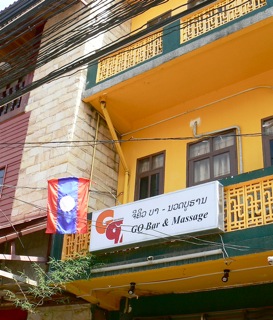
One sunny afternoon I met Jamle with a hello and a question. He was about to mount his motorbike in front of GQ bar (photo right) when he saw me aim my camera at the sign. "Is there something here?" he asked. I said I was taking the photo because I read it was a gay-friendly bar. Is that true? Yes, it was true. Thus a quick and spontaneous conversation ensued that ended with my inviting him to chat more at a popular gay-owned chic restaurant around the corner (where, for political reasons the owner asked not to be named. Several people interviewed for this story asked for the same anonymity.).
At lunch, this 28 year-old native Lao gave a helpful overview of the LGBT scene in Vientiane. The city has changed a lot in the ten years since I was here last, but the LGBT scene is much the same–it’s bigger yet still quiet, playful, social, blended into the larger social scene and enjoying the benefits of discretion, and with more gay-owned businesses.
The presence of activists or advocates for gay or equal rights does not seem necessary or desireable in this culture where modesty and privacy are more important than public politics or declarative voices. The result is a peaceful way of gay life that is somewhat known by the public and certainly known by the authorities. However, virtually no one is persecuted as long as there is no disturbance or demands on the government.
GQ Bar used to be a bar and massage place but they stopped the body rubs and now just serve drinks. It is one of three hangouts but does not publicize itself as gay; ‘gay-friendly’ is the key word for Internet reference but is not favored inside Laos. The designation is used with caution since no one wants to draw attetion to their venue, although some owners are more bold than others and don’t mind the ‘gay friendly’ label. Others requested that I not use the phrase to describe their places.
The second ‘friendly’ bar is modest-sized Somla Bar on the main street around the corner from GQ. The third venue is a bar-disco that comes alive after the straight folks leave (except for those who like the switch), Bor Pen Nyang Pub overlooking the Mekong River.
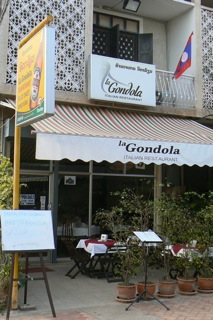 Beside the bars there are two restaurants, one Italian one French, both owned by members of the community and both with excellent cuisine. There is also Syri 2 Guesthouse that’s rather worn and with a backbacker look.
Beside the bars there are two restaurants, one Italian one French, both owned by members of the community and both with excellent cuisine. There is also Syri 2 Guesthouse that’s rather worn and with a backbacker look.
As well as these commercial businesses in the capital, there are numerous ‘friendly’ venues in Luang Prabang, the ancient capital city 200 kms north of Vientiane. (See the story.)
A recent feature of these ‘faring-owned’ places is that ownership of the businesses is now allowed to foreigners (versus ten years ago); however, they cannot own the property on which the business stands. For that a Lao partner is needed and in most situations the Lao partner is also a close ‘intimate’ of the farang.
One such partnership that seemed to be going well is the Lao-Italian owners of La Gondola Restaurant. As one partner explained, any foreigner who takes on a Lao partner is not just linking with a single person. Family ties are very strong in Laos and families tend to be large–six or eight siblings–and it goes without saying that the entire family expects to profit from the business, whether a bar, cafe, restaurant, hotel or travel agency.
It is understood–it should be understood–by the foreign investor that this is a non-negotiable item. No young Lao son would consider keeping his business affairs separate; perhaps the family might not be fully aware of the romantic connection, but sharing in the business matters is typical and customary.
This can work for or against the foreign partner. I have encountered strong relationships in Laos that have lasted well over ten years. But I have also seen the opposite where the business fails or the relationship fails and the foreigner loses his money to a greedy Lao family who technically own all or part of the investment. Any foreigner who fails to understand completely the complexities of Lao commercial regulations and tangled family ties is risking a fall, so trust is a priority issue.
Gay In Laos is Different 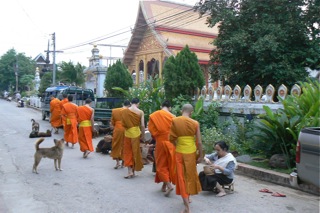
Being gay in the Lao culture is different–is reacted to differently–than in the West because of the prevailing Buddhist influence; there are, virtually, temples on every other corner.
Each morning at 6AM hundreds of saffron-robed monks, from ten to eighty years of age, walk in single file along certain streets and are given food donation into their begging bowls by local women. (photo right) While not embracing homosexuality, Buddhism does not condemn it as other religions do. The result is a distinct lack of homophobia; rather, there is an indifference (for those who know what it is) or. mostly, an ignorance of same-sex intimacy.
In the West there is a high priority for equality and tolerance so there is much political tension and conflict as well as religious homophobia that runs deep in Judeo-Christian based cultures. "However," Jamle explained, "the religion here in Laos is tolerant of differences among people and does not make homosexuality a sin or a mental illness; it is seen as an deviation in karmic development"–some would say it’s a result of wrong behavior in a previous heterosexual life!
For many Lao, especially outside urban areas, they do not know what is sexual orientation is and don’t know what two men or women might do in bed together.
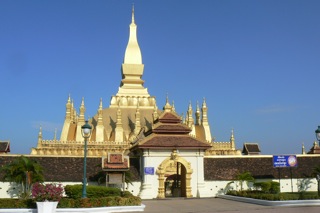 Said one man, "although the government is politically repressive, they tend to leave the gay community alone since we don’t stir up problems." In the capital city of Vientiane there is no gay center or leader to focus a concerted gay ‘community’. Not making waves is an imposed guiding force that induces self-censorship among the citizenry. Rather, many LGBT people here quietly scatter around to their favorite disco, restaurant, cafe or club in the city for social life, riding on thousands of noisy motorbikes.
Said one man, "although the government is politically repressive, they tend to leave the gay community alone since we don’t stir up problems." In the capital city of Vientiane there is no gay center or leader to focus a concerted gay ‘community’. Not making waves is an imposed guiding force that induces self-censorship among the citizenry. Rather, many LGBT people here quietly scatter around to their favorite disco, restaurant, cafe or club in the city for social life, riding on thousands of noisy motorbikes.
In the ‘old’ days, before the 1975 communist takeover, the only known place to gather was by Nam Phou, the big fountain in the city center. With development and ambition, the country has become more of a capitalist social state with countless private enterprises that includes those favorite gay-straight friendly venues that appeal to young and middle-age people.
Trans People (Kathoeys)
But not all is pleasant and polite. For others folks, for the ‘T’ in LGBT, life doesn’t run as smoothly as for the other LGB people in Laos. During my visit, transvestite and transsexual kathoey (or katoey) people were being stopped when seen in public, taken to the police station and given a warning about their appearance. One rumor had it that the police were cutting kathoeys’ long hair but this was denied by Toup, the owner of Somla Bar, a mixed venue favorite hangout for kathoeys.
 Toup said the police usually don’t hassle the ‘ladies’ but this November was a special time as Laos is celebrating two big events, the yearly Ban Luang merit festival as well as the 250th anniversary of Vientiane becoming the capital. So the streets are being cleaned, the temples painted, colorful flags (Rainbow colors!) flown, flower beds installed, and special governmental celebration ceremonies planned. The ‘ladies’ are not welcome to be out, loud or proud– as if they ever are.
Toup said the police usually don’t hassle the ‘ladies’ but this November was a special time as Laos is celebrating two big events, the yearly Ban Luang merit festival as well as the 250th anniversary of Vientiane becoming the capital. So the streets are being cleaned, the temples painted, colorful flags (Rainbow colors!) flown, flower beds installed, and special governmental celebration ceremonies planned. The ‘ladies’ are not welcome to be out, loud or proud– as if they ever are.
Kathoeys (generic photo right) are a subset of the gay population that are generally most discriminated against by both gay and straight people for various reasons one of which is because sexuality is usually understood in polarities–male and female, gay and straight, each with culturally understood meanings, identities and behaviors.
But kathoeys blur these neat categories and confuse other people, especially heterosexual police and a conservative socialist government officials who view them as freakish and unwelcome, especially during the anniversary celebrations.
But a more sensible understanding is easily gained by talking to a kathoey and seeing her as a real person–‘her’ meaning that most kathoeys are male-to-female cross dressers who identify with beinq more female than male. Very few in Laos have completed the transition with reassignment surgery because of the cost and will retain their male organs as well as take hormones to develop female-size breasts.
Research on Kathoeys
An unexpected meeting in Vientiane with a social researcher, Serge Doussantousse, (http://www.sercasia.com/) led to a discussion about kathoeys over the age of forty. Serge, who runs a consulting service Social Environment Research Consultants (SERC) in Vientiane, informed me of a 2009 report that he co-authored with Dr. Sam Winter, a professor at Hong Kong University and well-know transgender researcher. In their report they wrote, "large numbers of Lao transwomen use hormones without at any time consulting a medical professional, nor being aware of many of the more major risks associated with these hormones." (Also see his 2005 report on Kathoeys)
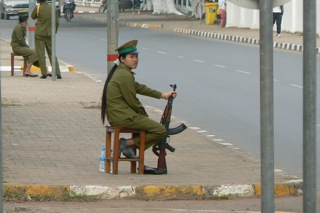 It’s fairly easy to present oneself as a pretty fresh-faced young trans and attract friends and particular sex mates who enjoy androgyny. But long-term hormone use by these people has led to health problems as they age. The purpose of the study was to discern specific problems of long-term hormone use (fatigue, nausea and dizziness, weight gain, mood changes and complexion changes) and to raise awareness about trans health needs.
It’s fairly easy to present oneself as a pretty fresh-faced young trans and attract friends and particular sex mates who enjoy androgyny. But long-term hormone use by these people has led to health problems as they age. The purpose of the study was to discern specific problems of long-term hormone use (fatigue, nausea and dizziness, weight gain, mood changes and complexion changes) and to raise awareness about trans health needs.
An interesting sidebar about kathoeys is the ‘function’ they serve in society, often as ‘professional service (sex) workers’. For many young straight boys, their first sexual experience is often with a kathoey because straight ‘good’ girls are not available and prostitution is illegal. Happily for the young guys there is no risk of pregnancy and, most helpful, kathoeys are sexually experienced and offer a ‘good time’ and some are willing to pay young guys for sex. (In turn, straight adult men pay kathoeys for sex.)
(Photo above left, female soldier; is this a way for a woman to mask her inner identity?)
The Unavoidable HIV
At lunch one day I talked with two dedicated and informative staff members of the World Health Organization (WHO emblem photo right) , Dr (Mr) Dominique Ricard, a medical officer originally from France and Dr (Mr) Tone Vixaysouk, a public health officer whose family is originally from Viet Nam.
Their task of combating HIV/AIDS is not easy: 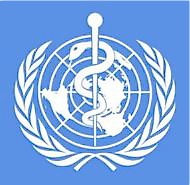
–a government survey found the HIV prevalence rate among men who have sex with men in Vientiane was 5.6%; that’s high for Laos, higher than the rate among other high-risk groups, including female sex workers. The general population prevalence of HIV in Laos measures at 0.2 percent. This means that a large proportion of HIV infections in Laos are caused by male-to-male transmission.
–in another study of 540 men, 40% of participants were MSM with 58% of these reporting also having sex with a woman.
–Condom use was low. Only 14% of men reported using condoms with a regular partner, 24% with a casual partner and 50% when having sex with a foreigner.
–only 6% of at-risk men had ever had an HIV test.
–Some researchers claim there is an "HIV epidemic among men who have sex with men in Vientiane. The three main modes of infection are: unprotected male-to-male sex with multiple partners; unprotected sex in the context of sex work; and unsafe injecting drug use. 95% of HIV infection among adolescents (throughout Asia) are via these three modes.
Dominique and Tone are acutely aware of the need for HIV education and treatment among a population of relatively unaware MSM people who, until recently, have had little knowledge about the disease. Although the HIV+ incidence in Laos is relatively low at the present time, their concern is for more effective prevention strategies among the rural population, mostly Hmong tribes (see this related article about Hmong attitudes toward homosexuals in America), where education in general and HIV awareness is seriously lacking. On the other hand, HIV knowledge among kathoeys in the major cities is high, said Dominique.
On the positive side, there is no opposition to such HIV efforts. The socialist government in Laos is supportive and the stigma found elsewhere in Asia against HIV (such as in Vietnam) is mostly absent here. Health care is free in the country including anti-retroviral medication. Currently there are 1500 people on medication in Vientiane with another 6500 HIV positive people who do not show symptoms.
Tone pointed out that one of their challenges is bi-sexuality among married men who are gay and have been forced into marriage by family pressure (58% of MSM report also having sex with a woman). "These are emotionally isolated men who try to avoid any contact or information beyond an occasional ‘quick-fix’ with other men. They can’t afford to be seen doing anything unusual, such as buying condoms or talking to foreign researchers."
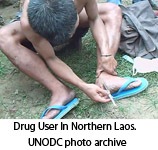 One of the more effective ways for outreaching to the different MSM populations (gay, bi, trans, commercial) is through peer counseling programs sponsored by such international organizations as WHO, CDC (USA), Burnett (Australia), UNESCO, PSI (Population Services International, which has a drop-in center in Vientiane). One-to-one peer counseling is one of the most effective methods of disseminating sex-related information in Asia. It is used extensively in India where sex talk is also mostly taboo.
One of the more effective ways for outreaching to the different MSM populations (gay, bi, trans, commercial) is through peer counseling programs sponsored by such international organizations as WHO, CDC (USA), Burnett (Australia), UNESCO, PSI (Population Services International, which has a drop-in center in Vientiane). One-to-one peer counseling is one of the most effective methods of disseminating sex-related information in Asia. It is used extensively in India where sex talk is also mostly taboo.
IRIN/PlusNews reports that the program’s peer educators visit places young men are most likely to gather, such as beer shacks, saunas or video shops. Bouapha said that the peer educators are trained to discuss HIV and other sexually transmitted infection prevention, as well as how to approach MSM so that they feel comfortable asking questions.
A major publication titled ‘Mekong Erotics: Men Loving/Pleasuring/Using Men in Lao PDR‘, over 100 pages, was issued in 2009 on this crucial issue. It contains this warning: "Asian countries will be unable to retain their status of ‘low level’ epidemic and/or reduce overall population prevalence below 0.1 percent without scaling up HIV prevention, care and support interventions for MSM. We know that unprotected anal sex is an effective route for transmission of HIV…"
Prior to 2006, Laos had few commercial sex workers (now called ‘service women’) and government concern was minimal toward them. But with the advent of HIV and its high affiliation with unsafe homosexual behavior, the leaders were forced to recognize the LGBT population and the risk of spreading an epidemic among the population at large. Sex is not a discussed issue, especially in the vast rural areas of Laos, so educators have re-framed sex education as ‘disease education’ which softens the topic, especially among monks, soldiers, police, parents and school teachers, explained Dominique. 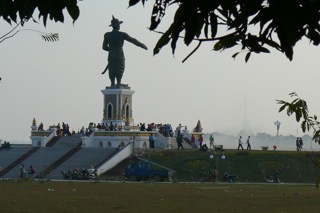
On a personal note, at dinner that evening Tone said he is out to his whole family of parents and six siblings. Having so many brothers and sisters, he laughed, takes pressure off him to get married and he can focus on his own choices. Many Lao families are similarly large and for gay men and women it is a secret blessing, despite the chaos of a crowded house.
It was good to have a lighter moment among all the talk about the complexities of gay life in modern Laos. (photo, new statue of King Chao Anouvong in the park along the Mekong River)















